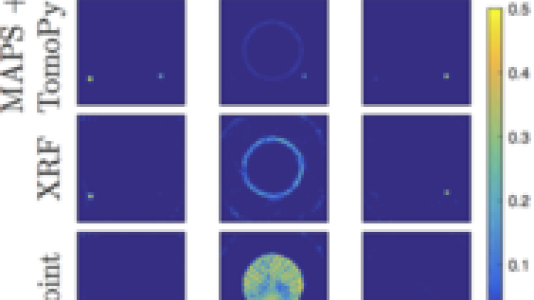
Researchers from Argonne National Laboratory and Northwestern University have received an “Editors’ Pick” award for their paper “Joint reconstruction of x-ray fluorescence and transmission tomography.”
The paper, which appeared in Optics Express in June 2017, was one of two papers chosen by the editorial board from more than 75 papers. Editor’s Picks highlight articles with excellent scientific quality and are representative of the work taking place in a specific field – in this case, image processing.
When a specimen is bombarded with x-rays, some of the them will interact with the material, causing the emission of x-ray fluorescence, or XRF. The process provides information about specific elements within the specimen. However, inaccuracies can result if fluorescent photons emitted in the specimen are absorbed in a nearby specimen – a process known as self-absorption.
X-ray transmission, or XRT, signals can be used to correct for the self-absorption effect because of its complementary information of XRF signals. As the specimen is rotated, one can build up sinograms ( i.e., views of XRT signals from different directions).
“By exploiting the complementary information of XRF and XRT signals and combining them, we can obtain a better reconstruction of the specimen,” said Zichao (Wendy) Di, an assistant computational scientist in Argonne’s Mathematics and Computer Science Division and lead author of the award-winning paper.
To reconstruct the sample, the researchers developed a new mathematical model to integrate XRF and XRT data and devised an optimization-based algorithm that estimates the unknown element distribution by iteratively correcting the self-absorption effect.
The Argonne/Northwestern team tested their new approach on a sample scanned at Argonne’s Advanced Photon Source. Comparing their results with the output of a widely used tomographic data-processing and image reconstruction library, the researchers found that their model is significantly better in distinguishing the different elemental signals and mitigating the self-absorption effect. Moreover, the method produces fewer artifacts, or errors in the reconstruction.
“Our prototype code right now does have a high computational cost, owing to a large memory requirement,” said Di. She and her colleagues will explore combining their method with different types of data acquisition or parallelizing the code and projections.
The award-winning paper by Zichao Wendy Di, Si Chen, Young Pyo Hong, Chris Jacobsen, Sven Leyffer, and Stefan M. Wild, “Joint reconstruction of x-ray fluorescence and transmission tomography,” Opt. Express 25(12) 13107-131124, is available on the web at http://www.Osapublishing.org/OE/abstract.cfm?uri=OE-25-12-13107